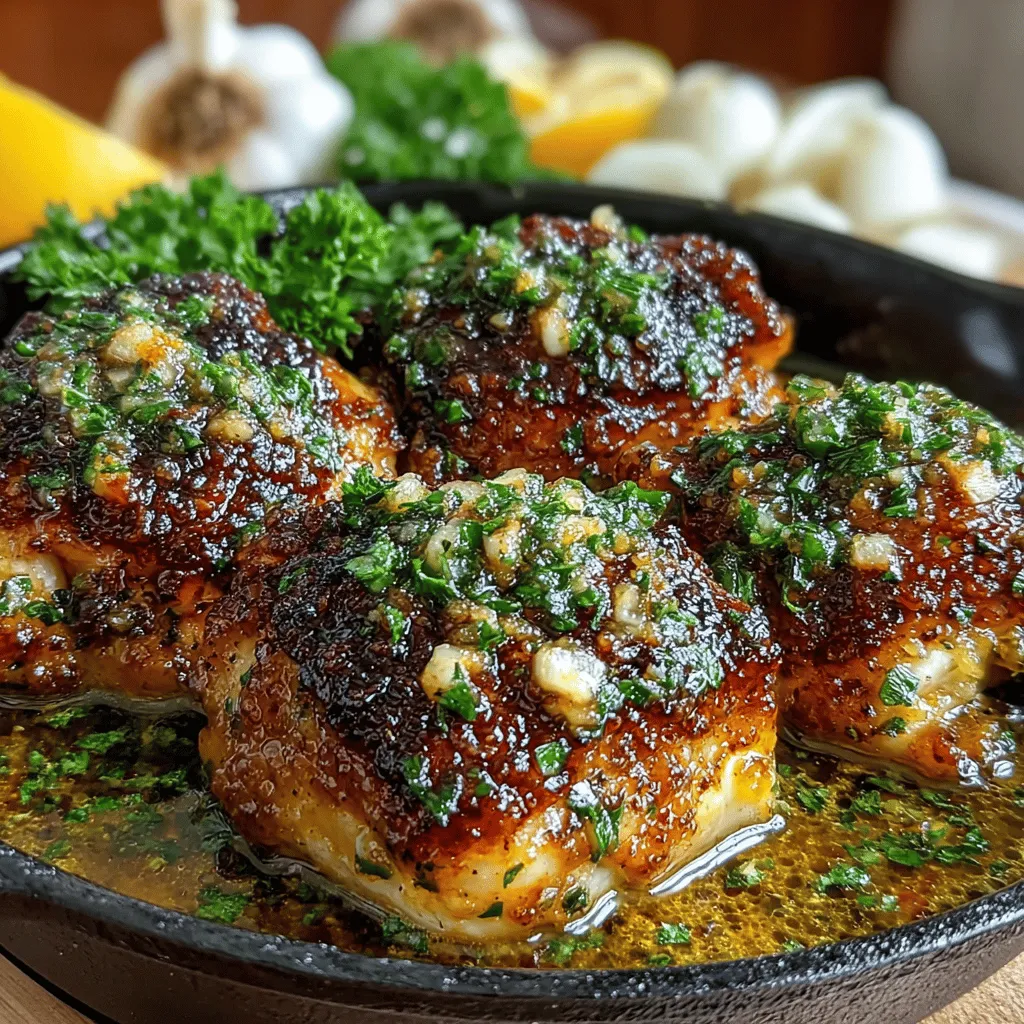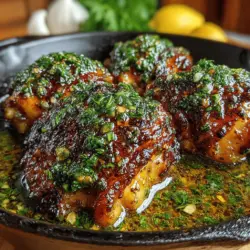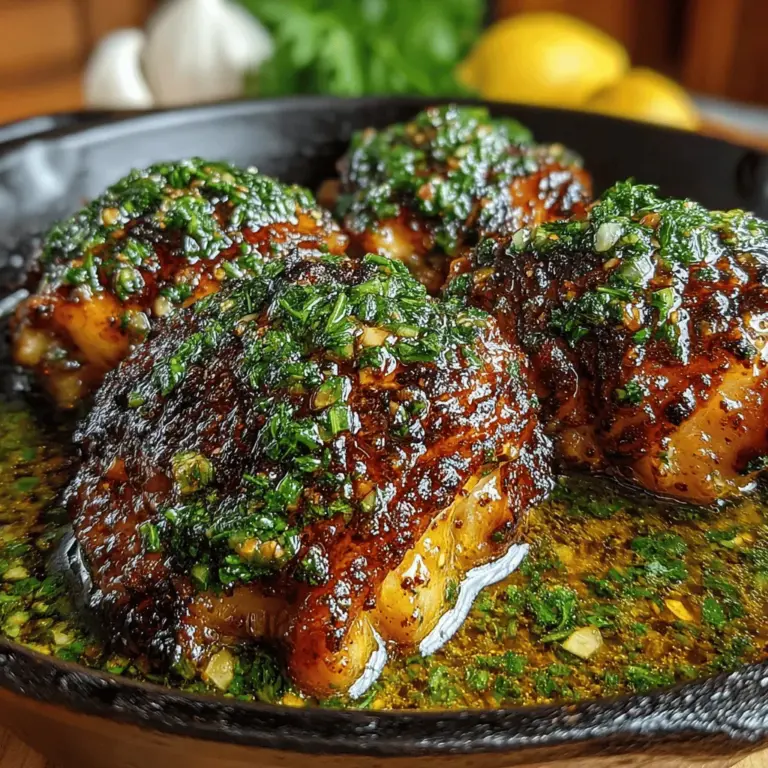Sweet & Savory Honey Mustard Chicken Thighs: An Introduction
When it comes to creating a meal that satisfies both the palate and the soul, few dishes can rival the allure of Sweet & Savory Honey Mustard Chicken Thighs. This delightful dish combines the rich, juicy flavor of chicken thighs with a luscious marinade that strikes the perfect balance between sweetness and tanginess. The result is a mouthwatering main course that’s not only easy to prepare but also perfect for family dinners, entertaining guests, or simply indulging in a comforting meal at home.
Chicken thighs are often celebrated in the culinary world for their succulent texture and robust flavor. Unlike chicken breasts, which can dry out easily, chicken thighs remain tender and juicy even after cooking. Their versatility allows them to shine in a variety of preparations, but when paired with a honey mustard glaze, they transform into a dish that will have everyone at the table asking for seconds. Whether you’re a novice cook or a seasoned chef, this recipe is designed to be straightforward, ensuring that you can whip up a delicious meal without spending hours in the kitchen.
In this article, we’ll take you through the process of making Sweet & Savory Honey Mustard Chicken Thighs, from understanding the essential ingredients to preparing a flavorful marinade that will elevate your dish. Get ready to impress your family and friends with a meal that is as visually appealing as it is delectable.
Understanding the Ingredients
To create the perfect Sweet & Savory Honey Mustard Chicken Thighs, it’s essential to understand the role each ingredient plays in this recipe. Let’s break down the key components that contribute to the dish’s irresistible flavor profile.
Chicken Thighs: The Star of the Dish
For this recipe, bone-in, skin-on chicken thighs are highly recommended. The bone helps retain moisture during cooking, ensuring that each bite is juicy and tender. The skin adds an extra layer of flavor and crispiness when roasted, making the dish more satisfying. While boneless, skinless thighs can be used, they may not deliver the same depth of flavor or moisture that bone-in, skin-on thighs provide.
Honey and Dijon Mustard: The Sweet and Tangy Duo
The heart of this recipe lies in the honey and Dijon mustard combination. Honey brings a natural sweetness that complements the savory elements of the chicken, while Dijon mustard adds a tangy kick that elevates the dish. Together, they create a glaze that caramelizes beautifully in the oven, resulting in a deliciously sticky and flavorful coating.
Olive Oil and Garlic: Enhancing Flavor and Moisture
To round out the marinade, olive oil and garlic are added. Olive oil not only helps to keep the chicken moist during cooking but also acts as a base for the marinade, allowing the flavors to meld together beautifully. Garlic introduces a savory depth that enhances the overall taste of the dish, making it even more irresistible.
Herbs and Spices: Adding Depth
To elevate the flavor profile further, a blend of herbs and spices is incorporated into the marinade. Fresh or dried thyme adds an earthy note, while smoked paprika introduces a hint of smokiness and warmth. A dash of salt and pepper is essential for balancing the flavors, ensuring that each component shines through without overpowering the others.
Lemon Zest: A Touch of Brightness
While optional, lemon zest can be a game-changer in this recipe. A small amount of lemon zest adds a refreshing brightness that cuts through the richness of the honey and chicken, providing a well-rounded flavor that is sure to impress.
Nutritional Benefits
In addition to being delicious, the ingredients in this recipe offer various nutritional benefits. Chicken thighs are a great source of protein and essential vitamins and minerals. Honey has natural antibacterial properties and is a healthier alternative to refined sugars. Olive oil is rich in healthy fats and antioxidants, while garlic is known for its immune-boosting properties. By choosing fresh herbs and spices, you not only enhance flavor but also add valuable nutrients to your meal.
Marinating for Flavor
One of the most important steps in preparing Sweet & Savory Honey Mustard Chicken Thighs is marinating the chicken. Marinating is a simple yet effective technique that enhances the flavor, tenderness, and juiciness of the chicken. By allowing the chicken to soak in the marinade, the flavors penetrate the meat, ensuring that each bite is bursting with taste.
Preparing the Marinade
To prepare the marinade for this dish, start by combining honey and Dijon mustard in a mixing bowl. The proportions can be adjusted according to your taste, but a good starting point is a 2:1 ratio of honey to mustard. Next, add minced garlic and olive oil, followed by the herbs and spices. Stir the mixture until all the ingredients are well incorporated. If you’re opting to include lemon zest, now is the time to add it in.
Balancing the Flavors
The key to a successful marinade is balance. You want to ensure that the sweetness of the honey complements the tanginess of the mustard without either overpowering the other. Taste the marinade before adding it to the chicken; if it’s too sweet, a splash more of Dijon mustard can help bring the flavors back into harmony. Conversely, if it’s too tangy, a touch more honey can sweeten it up.
Marinating Time
For optimal flavor, it is recommended to marinate the chicken thighs for at least 30 minutes, but ideally, you should aim for 2 to 4 hours. If time allows, marinating overnight in the refrigerator will yield the best results, allowing the chicken to absorb all the flavors deeply. Just be mindful not to exceed 24 hours, as the acidity in the marinade can begin to break down the meat fibers too much, leading to a mushy texture.
With this foundational understanding of the ingredients and marinating process, you’re well on your way to creating a deliciously memorable dish that embodies the sweet and savory essence of Honey Mustard Chicken Thighs. Stay tuned for the next part of the recipe, where we’ll guide you through the cooking process that brings this dish to life.

Cooking Techniques for Perfect Chicken Thighs
To achieve the perfect sweet and savory honey mustard chicken thighs, mastering a few cooking techniques is essential. Here’s how to ensure your chicken is tender, juicy, and flavorful.
Preheating the Oven: Why It’s Essential for Even Cooking
Preheating your oven is a crucial step for achieving evenly cooked chicken thighs. When the oven reaches the desired temperature before you put the chicken in, it helps to seal in the juices quickly, preventing dryness. This step also ensures that the honey mustard glaze caramelizes beautifully, enhancing the flavor and texture of the dish.
Searing the Chicken: Tips for Achieving Crispy Skin
Searing is the key to achieving that irresistible crispy skin on chicken thighs. Here are some tips to get it just right:
1. Use a Heavy Skillet: A cast-iron skillet or a stainless-steel pan is ideal for searing chicken. These materials retain heat well and provide a nice sear.
2. High Heat: Heat your skillet over medium-high heat until it’s hot. You can test if it’s ready by adding a drop of water; it should sizzle immediately.
3. Oil: Add a high smoke-point oil, such as canola or avocado oil, to the skillet. This helps achieve a golden-brown crust.
4. Don’t Overcrowd: Place only a few chicken thighs in the pan at a time. Overcrowding lowers the skillet’s temperature, preventing a proper sear.
5. Patience: Allow the chicken to sear undisturbed for about 5-7 minutes on one side before flipping. This patience will reward you with crispy skin.
Importance of Patting the Chicken Dry
Before cooking, patting the chicken thighs dry with paper towels is critical. Moisture on the surface can steam the chicken instead of searing it, resulting in less crispy skin. By removing excess moisture, you enhance the browning process, leading to better flavor and texture.
Recommended Skillet Types and Heat Settings
For the best results, use a heavy-bottomed skillet like cast iron, which distributes heat evenly and retains it well. Set your heat to medium-high for searing. After searing, you can lower the heat slightly when adding the glaze and transferring the skillet to the oven to finish cooking.
Baking: The Science Behind Cooking Chicken to the Right Temperature
Once the chicken has been seared to perfection, it’s time to bake it. The ideal internal temperature for chicken thighs is 165°F (74°C). Use a meat thermometer to check the thickness of the thigh, inserting it into the thickest part without touching the bone. This ensures that your chicken is both safe to eat and tender.
Discussing Safe Cooking Temperatures and How to Check Them
To guarantee food safety, always ensure that chicken reaches an internal temperature of 165°F (74°C). However, for even juicier chicken, you can cook thighs to an internal temperature of 175°F (80°C) without compromising texture. Using a digital meat thermometer will help you accurately monitor the temperature, ensuring your chicken is perfectly cooked every time.
Glazing for Extra Flavor
One of the highlights of this honey mustard chicken dish is the glaze, which not only enhances flavor but also adds an attractive sheen.
Exploring the Option of Glazing the Chicken Thighs During Baking
Glazing the chicken thighs during the last 10-15 minutes of baking can significantly elevate the dish. This process allows the sugars in the honey and mustard to caramelize, creating a sticky, flavorful coating that clings to the chicken.
How Glazing Enhances Appearance and Adds a Layer of Flavor
The glaze not only adds depth to the flavor profile but also gives the chicken an appealing golden-brown color. For a more robust flavor, consider brushing the chicken with additional glaze halfway through the baking process. This step will ensure that every bite is bursting with that sweet and tangy goodness.
Tips for Using Remaining Marinade Safely
If you have leftover marinade, it’s essential to handle it safely. Never use raw marinade on cooked chicken, as it can lead to foodborne illnesses. Instead, reserve some marinade before adding the chicken or boil leftover marinade for at least 5 minutes to kill any harmful bacteria. This can then be used as a sauce to drizzle over the finished dish.
Serving Suggestions
Once your honey mustard chicken thighs are cooked to perfection, it’s time to serve them up! Here are some delicious side dish ideas to accompany this delightful main course.
Ideas for Side Dishes that Complement Honey Mustard Chicken Thighs
1. Roasted Vegetables: Seasonal vegetables such as carrots, Brussels sprouts, and sweet potatoes roasted with olive oil and herbs make a colorful and nutritious side.
2. Rice: A fluffy serving of jasmine or basmati rice can soak up the delicious glaze from the chicken. Consider adding some herbs or spices to the rice for an extra flavor kick.
3. Fresh Salad: A simple green salad with mixed greens, cherry tomatoes, cucumber, and a light vinaigrette provides a refreshing balance to the richness of the chicken.
Suggestions for Meal Pairings: Drinks and Additional Sides
Pair your honey mustard chicken thighs with a refreshing beverage. A crisp white wine, like Sauvignon Blanc or a lightly brewed iced tea, can complement the sweetness of the glaze. For additional sides, consider garlic bread or creamy mashed potatoes; both can enhance the overall meal experience.
Conclusion
In conclusion, sweet and savory honey mustard chicken thighs are a simple yet flavorful dish that can impress at any dinner table. With the right cooking techniques, you can achieve crispy, juicy chicken that is packed with delicious flavor. The versatility of this dish allows it to shine in a variety of settings, whether it’s a weeknight dinner or a special gathering with friends and family.
We encourage you to try this recipe and enjoy the delightful results. With its balance of sweet and tangy flavors and satisfying textures, honey mustard chicken thighs are sure to become a favorite in your culinary repertoire. Don’t hesitate to experiment with different sides and pairings, making this dish your own for every occasion. Happy cooking!


